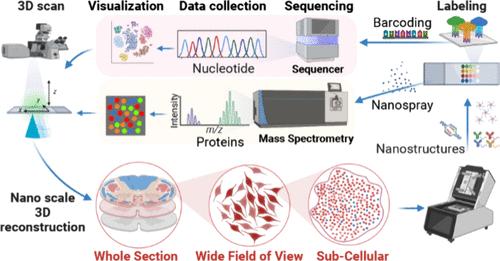纳米技术在空间组学中的应用:纳米级分辨率下的生物结构和功能
IF 16
1区 材料科学
Q1 CHEMISTRY, MULTIDISCIPLINARY
引用次数: 0
摘要
空间组学方法是传统组织学方法的延伸,通过在组织或单个细胞内以微尺度分辨率检查生物分子(包括核酸、蛋白质、脂质和代谢物)的分布,可以阐明生理和疾病的重要生物医学机制。由于在某些应用中,空间组学的期望分辨率接近纳米尺度,因此经典工具在应用于空间组学分析时具有固有的局限性,并且它们只能测量有限数量的目标。纳米技术的应用在克服这些瓶颈方面发挥了重要作用。当空间组学需要纳米级分辨率时,需要超分辨率显微镜或检测成像技术,如质谱成像,来生成精确的目标表达空间图像。DNA纳米结构在空间组学中广泛应用于核酸检测、信号扩增、DNA条形码标记等目的,凸显了空间组学的进步。纳米技术的其他特性包括先进的空间组学方法,如微流控芯片和DNA条形码。在这篇综述中,我们描述了纳米技术如何应用于空间转录组学、蛋白质组学、代谢组学、表观基因组学和多组学方法的发展。我们专注于纳米技术如何支持提高空间组学的分辨率和吞吐量,超越传统技术。我们还总结了纳米技术在空间组学方法中的应用面临的挑战和机遇。本文章由计算机程序翻译,如有差异,请以英文原文为准。

Applications of Nanotechnology for Spatial Omics: Biological Structures and Functions at Nanoscale Resolution
Spatial omics methods are extensions of traditional histological methods that can illuminate important biomedical mechanisms of physiology and disease by examining the distribution of biomolecules, including nucleic acids, proteins, lipids, and metabolites, at microscale resolution within tissues or individual cells. Since, for some applications, the desired resolution for spatial omics approaches the nanometer scale, classical tools have inherent limitations when applied to spatial omics analyses, and they can measure only a limited number of targets. Nanotechnology applications have been instrumental in overcoming these bottlenecks. When nanometer-level resolution is needed for spatial omics, super resolution microscopy or detection imaging techniques, such as mass spectrometer imaging, are required to generate precise spatial images of target expression. DNA nanostructures are widely used in spatial omics for purposes such as nucleic acid detection, signal amplification, and DNA barcoding for target molecule labeling, underscoring advances in spatial omics. Other properties of nanotechnologies include advanced spatial omics methods, such as microfluidic chips and DNA barcodes. In this review, we describe how nanotechnologies have been applied to the development of spatial transcriptomics, proteomics, metabolomics, epigenomics, and multiomics approaches. We focus on how nanotechnology supports improved resolution and throughput of spatial omics, surpassing traditional techniques. We also summarize future challenges and opportunities for the application of nanotechnology to spatial omics methods.
求助全文
通过发布文献求助,成功后即可免费获取论文全文。
去求助
来源期刊

ACS Nano
工程技术-材料科学:综合
CiteScore
26.00
自引率
4.10%
发文量
1627
审稿时长
1.7 months
期刊介绍:
ACS Nano, published monthly, serves as an international forum for comprehensive articles on nanoscience and nanotechnology research at the intersections of chemistry, biology, materials science, physics, and engineering. The journal fosters communication among scientists in these communities, facilitating collaboration, new research opportunities, and advancements through discoveries. ACS Nano covers synthesis, assembly, characterization, theory, and simulation of nanostructures, nanobiotechnology, nanofabrication, methods and tools for nanoscience and nanotechnology, and self- and directed-assembly. Alongside original research articles, it offers thorough reviews, perspectives on cutting-edge research, and discussions envisioning the future of nanoscience and nanotechnology.
 求助内容:
求助内容: 应助结果提醒方式:
应助结果提醒方式:


